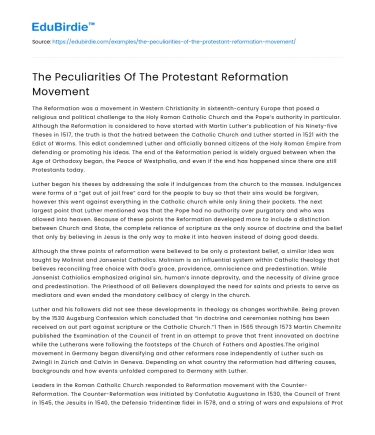The Reformation was a movement in Western Christianity in sixteenth-century Europe that posed a religious and political challenge to the Holy Roman Catholic Church and the Pope’s authority in particular. Although the Reformation is considered to have started with Martin Luther’s publication of his Ninety-five Theses in 1517, the truth is that the hatred between the Catholic Church and Luther started in 1521 with the Edict of Worms. This edict condemned Luther and officially banned citizens of the Holy Roman Empire from defending or promoting his ideas. The end of the Reformation period is widely argued between when the Age of Orthodoxy began, the Peace of Westphalia, and even if the end has happened since there are still Protestants today.
Luther began his theses by addressing the sale if indulgences from the church to the masses. Indulgences were forms of a “get out of jail free” card for the people to buy so that their sins would be forgiven, however this went against everything in the Catholic church while only lining their pockets. The next largest point that Luther mentioned was that the Pope had no authority over purgatory and who was allowed into heaven. Because of these points the Reformation developed more to include a distinction between Church and State, the complete reliance of scripture as the only source of doctrine and the belief that only by believing in Jesus is the only way to make it into heaven instead of doing good deeds.
Save your time!
We can take care of your essay
- Proper editing and formatting
- Free revision, title page, and bibliography
- Flexible prices and money-back guarantee
Although the three points of reformation were believed to be only a protestant belief, a similar idea was taught by Molinist and Jansenist Catholics. Molinism is an influential system within Catholic theology that believes reconciling free choice with God's grace, providence, omniscience and predestination. While Jansenist Cathiolics emphasized original sin, human’s innate depravity, and the necessity of divine grace and predestination. The Priesthood of all Believers downplayed the need for saints and priests to serve as mediators and even ended the mandatory celibacy of clergy in the church.
Luther and his followers did not see these developments in theology as changes worthwhile. Being proven by the 1530 Augsburg Confession which concluded that “in doctrine and ceremonies nothing has been received on out part against scripture or the Catholic Church.”1 Then in 1565 through 1573 Martin Chemnitz published the Examination of the Council of Trent in an attempt to prove that Trent innovated on doctrine while the Lutherans were following the footsteps of the Church of Fathers and Apostles.The original movement in Germany began diversifying and other reformers rose independently of Luther such as Zwingli in Zürich and Calvin in Geneva. Depending on what country the reformation had differing causes, backgrounds and how events unfolded compared to Germany with Luther.
Leaders in the Roman Catholic Church responded to Reformation movement with the Counter-Reformation. The Counter-Reformation was initiated by Confutatio Augustana in 1530, the Council of Trent in 1545, the Jesuits in 1540, the Defensio Tridentinæ fidei in 1578, and a string of wars and expulsions of Protestants that continued until the 19th century. With most of Northern Europe becoming influenced by Protestantism, except for most of Ireland, and Southern Europe remaining mostly Catholic the expulsions of Protestants continued even following World War II. With the removal of ethnic Germans to either East Germany or Siberia this caused a large reduction in Protestantism in the Warsaw Pact countries, though some still remain to today.
Absence of Protestants however, does not automatically imply that the Reformation failed. Although Protestants were excommunicated and ended up worshiping in communions separate from Catholics, against the original intention of the Reformers, they were also suppressed and persecuted in most of Europe. As a result, some of them lived as crypto-Protestants, also called Nicodemites2, contrary to the teachings of John Calvin, who wanted them to practice their faith openly.
Common factors that played a role during the Reformation and the Counter-Reformation were the rise of nationalism, simony, the appointment of Cardinal-nephews, the impact of humanism, the Renaissance, the shift between the new theories of knowledge known as schola moderna and schola antiqua, and the Western Schism that ground away at people’s loyalty to the Pope. Unrest because of the Great Schism of Western Christianity caused wars between princes, uprisings in the lower classes, and widespread concern over corruption in the Church, especially from John Wycliffe at Oxford University and from Jan Hus at the Charles University in Prague.
Jan Hus objected to the practices of the Roman Catholic Church and wanted to return the church to the earlier practices as it was in Bohemia and Moravia. These practices included services in the languages of the people, allowing all people to take communion, priests being able to marry, and completely eliminating indulgences along with the concept of Purgatory. Hus rejected indulgences and believed that one could be allowed into heaven by grace through faith alone. The leaders of the Roman Catholic Church didn’t knot like this thinking and condemned him at the Council of Constance by burning him at the stake despite promising he would be safe. John Wycliffe was condemned as a heretic and his corpse was exhumed and burned in 1428. The Council of Constance confirmed and strengthened the medieval concept of church and empire being one in the same. The council did not address the tensions of the nation or the theological tensions incited during the previous century and could not prevent schism or the Hussite Wars in Bohemia.
References
- Barrett, Matthew, and Michael Horton. Reformation Theology: A Systematic Summary. (Crossway, 2017), 326.
- Appold, Kenneth G. The Reformation: A Brief History (John Wiley & Sons, 2011), 58.






 Stuck on your essay?
Stuck on your essay?

